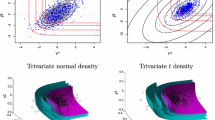Abstract
Assumptions about the dynamic and distributional behavior of risk factors are crucial for the construction of optimal portfolios and for risk assessment. Although asset returns are generally characterized by conditionally varying volatilities and fat tails, the normal distribution with constant variance continues to be the standard framework in portfolio management. Here we propose a practical approach to portfolio selection. It takes both the conditionally varying volatility and the fat-tailedness of risk factors explicitly into account, while retaining analytical tractability and ease of implementation. An application to a portfolio of nine German DAX stocks illustrates that the model is strongly favored by the data and that it is practically implementable.
Similar content being viewed by others
References
Akgiray V., Booth G.G. (1988). The stable law model of stock returns. Journal of Business and Economics Statistics, 6: 51–57
Bawa V.S., Lindenberg E.B. (1977). Capital market equilibrium in a mean-lower partial moment framework. Journal of Financial Economics, 5: 189–200
Belkacem, L., Lèvy-Vèhel, J., & Walter, C. (1995). Generalized market equilibrium: Stable CAPM, unpublished manuscript.
Belkacem L., Lèvy-Vèhel J., Walter C. (2000). CAPM, risk and portfolio selection in α-stable markets. Fractals, 8: 99–116
Blattberg R., Sargent T.J. (1971). Regression with non-gaussian stable disturbances: Some sampling results. Econometrica, 39: 501–510
Bollerslev T. (1986). Generalized autoregressive conditional heteroskedasticity. Journal of Econometrics, 31: 307–327
Christoffersen P.F. (2003). Elements of financial risk management. London, Academic Press
DeGroot, M. H. (1986). Probability and statistics. 2nd edn. Reading, Massachusetts, Addison-Wesley
Doganoglu T., Mittnik S. (1998). An approximation procedure for asymmetric stable densities. Computational Statistics, 13: 463–475
Doganoglu, T., & Mittnik, S. (2004). The Estimation of Multivariate Stable Paretian Index Models, unpublished manuscript.
Elton E.J., Gruber M.J., Bawa V.S. (1979). Simple rules for optimal portfolio selection in stable paretian markets. Journal of Finance, 34: 1041–1047
Engle R.F. (1982). Autoregressive Conditional Heteroscedasticity with Estimates of the Variance of United Kingdom Inflation. Econometrica 50(4): 987–1007
Fama E.F. (1965a). The behavior of stock market prices. Journal of Business, 38: 34–105
Fama E.F. (1965b). Portfolio analysis in a stable paretian market. Management Science, 11: 404–419
Fama E.F. (1971). Risk, return and equilibrium. Journal of Political Economy, 77: 31–55
Gamrowski B., Rachev S.T. (1999). A testable version of the pareto-stable CAPM. Mathematical and Computer Modelling, 29: 61–82
Harlow W.V., Rao R.K.S. (1989). Asset pricing in a generalized mean-lower partial moment framework: Theory and evidence. Journal of Financial and Quantitative Analysis, 24: 394–419
Kurz-Kim, J.-R., Rachev, S. T., Samorodnitsky, G. (2004). Asymptotic distribution of unbiased linear estimators in the presence of heavy-tailed stochastic regressors and residuals. mimeo.
McCulloch J. H. (1997). Measuring Tail Thickness to Estimate the Stable Index α: A Critique. Journal of Business and Economics Statistics, 15: 74–81
McCulloch, J. H. (1998). Numerical approximation of the symmetric stable distribution and densitiy. In R.J. Adler, R. Feldman, M.S. Taqqu, (Eds.), A practical guide to heavy tails, Boston, MA: Birkhauser.
Mittnik S., Doganoglu T., Chenyao D. (1999). Computing the probability density function of the stable paretian distribution. Mathematical and Computer Modelling, 29: 235–240
Mittnik S., Rachev S.T. (1993). Modeling stock returns with alternative stable distribution. Econometric Reviews, 12: 261–330
Mittnik S., Rachev S.T., Doganoglu T., Chenyao D. (1999). Maximum likelihood estimation of the stable paretian models. Mathematical and Computer Modelling, 29: 275–293
Nolan J.P. (1999). An algorithm for evaluating stable densities in Zolotarev’s (M) parameterization. Mathematical and Computer Modelling, 29: 229–233
Panorska A., Mittnik S., Rachev S. (1995). Stable ARCH modles for financial time series. Applied Mathematic Letters, 8(4): 33–37
Rachev S.T., Mittnik S. (2000). Stable paretian models in finance. Chichester, Wiley
RiskMetrics Group (1996). RiskMetrics—Technical Document. 4th edition. http://www.riskmetrics.com/research/techdoc/index.cgi
Samorodnitsky G., Taqqu M.S. (1994). Stable non-gaussian random processes. New York, Chapman & Hall
Author information
Authors and Affiliations
Corresponding author
Rights and permissions
About this article
Cite this article
Doganoglu, T., Hartz, C. & Mittnik, S. Portfolio optimization when risk factors are conditionally varying and heavy tailed. Comput Econ 29, 333–354 (2007). https://doi.org/10.1007/s10614-006-9071-1
Received:
Accepted:
Published:
Issue Date:
DOI: https://doi.org/10.1007/s10614-006-9071-1




